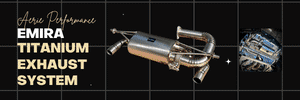It seems for a long time now most if not all sports car manufacturers offer their cars with adaptive dampers on the suspensions.
I've noticed with all Lotus models from the Elise through the Exige, the Evora and lastly the Emira, Lotus does not offer adaptive dampers on any of their sports cars.....why?
Is it because they feel that after they have developed/tested their cars they don't feel adaptive dampers are necessary?
I think it would be kind of nice to have them on the Emira, one setting calibrated for comfort/touring and a second setting calibrated for the racetrack.
That way customers would not have to choose one or the other.
You would think if Honda can do it for the CivictType-r Lotus would be able to as well for the Emira.
What are you gents think?
I've noticed with all Lotus models from the Elise through the Exige, the Evora and lastly the Emira, Lotus does not offer adaptive dampers on any of their sports cars.....why?
Is it because they feel that after they have developed/tested their cars they don't feel adaptive dampers are necessary?
I think it would be kind of nice to have them on the Emira, one setting calibrated for comfort/touring and a second setting calibrated for the racetrack.
That way customers would not have to choose one or the other.
You would think if Honda can do it for the CivictType-r Lotus would be able to as well for the Emira.
What are you gents think?







